Sacred Summits: Greece’s Ancient Mountain Sanctuaries
From Crete to Olympus, hike the...
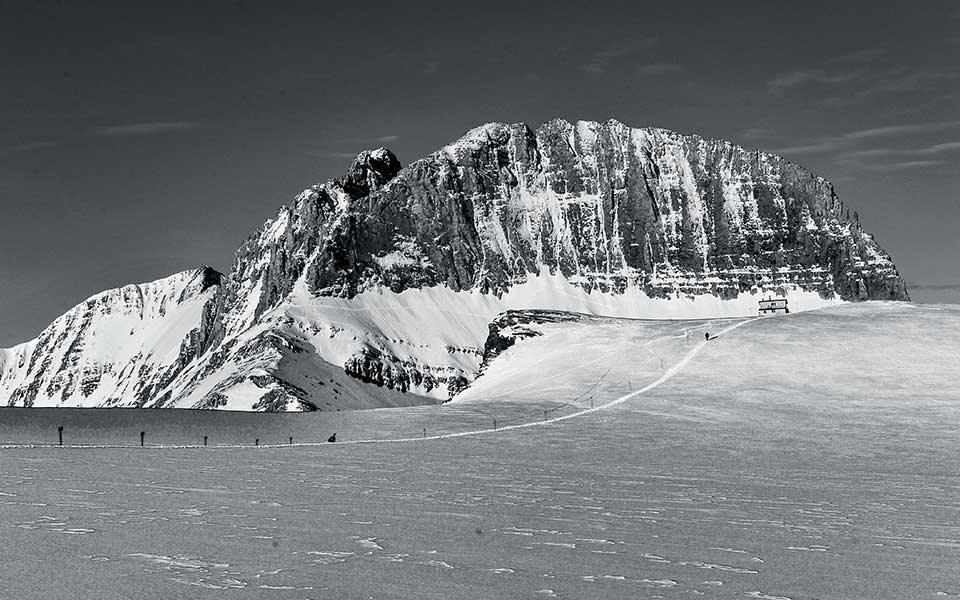
The peaks of Mt Olympus are covered by snow from early autumn through to the start of summer.
© Babis Giritziotis
I am on Mt Olympus, on December 29, 2015. It’s minus 32°C. The deafening wind is blowing so hard we’re unable to communicate with those only a few feet away.
The small patches of exposed skin on our faces are being burnt by the brutal, biting cold. It is cutting through our clothes, dangerously chilling our bodies. Any fall would be the last. On both sides, the ridge drops straight down into a deep 1500m void.
During winter on Olympus, the Laimos Ridge is the only possible route leading to the Plateau of the Muses. The path narrows to barely 20cm over a few hundred meters. Like a thread, it stretches out along a terrifying cornice.
For two days, we had ploughed forward. For two days, our group, myself and the Kakkalos Refuge team, had struggled through deep heavy snow. The prolonged cold starts to work through my boots, freezing my toes. (One of the team would later suffer frostbite to his cheek.)
Breathing hard through our noses, our breath freezes in small ice crystals. Our goggles shield our eyes from the bitter wind, keeping them from freezing shut. To top it off, I know that if things get worse, there will be no rescue team.
After what feels like an eternity, we finally make it to the refuge.
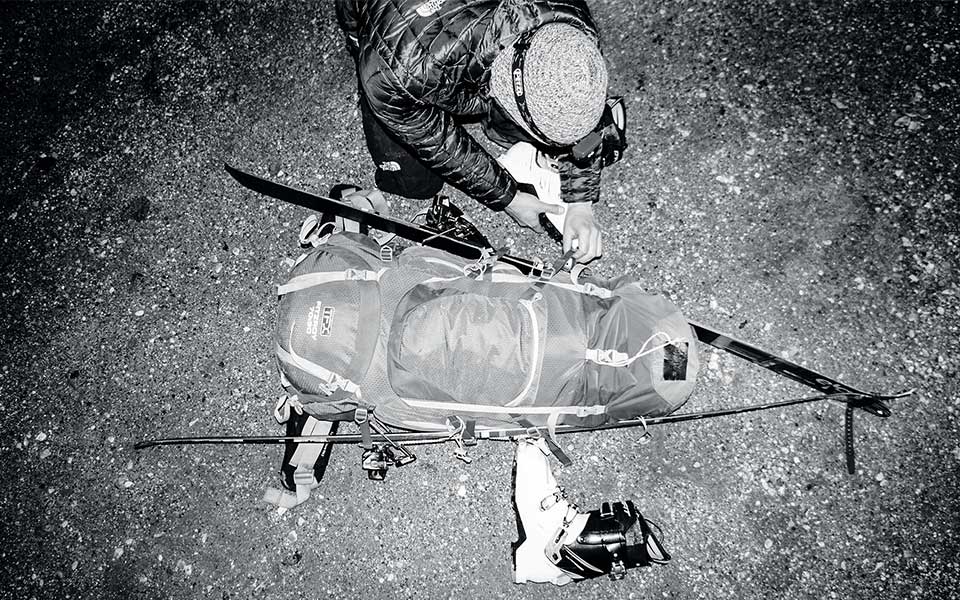
Mike Styllas prepares his 40kg backpack for the hike. Inside the bag is an entire stuffed turkey, ready for the New Year’s dinner at the refuge.
© Anne Viry-Babel
It’s still so clear in my memory. Upon arrival, we found the lock of the door frozen, and had to use lighters and oil to thaw it before we could slide the key in. We finally made it inside only to find the stove out of commission. The wind had blown snow inside the building through the chimneys. And, of course, the outside toilets were buried under meters of snow.
At this point, I had to wonder why it was that I never seemed to learn from experience. After all, this wasn’t my first winter ascent. Two years prior to this glacial moment, I had discovered Olympus when working for a French television production company. At that time, we were producing a one-hour documentary focusing on inspiring people who were living in harmony with nature in the wilderness. I was 28, and it was my first film as a director.
What I knew about Greece wouldn’t have covered a single sheet of paper. Looking for subjects for a film, I had turned to a map of Greece and fallen upon Mt Olympus. At 2918 meters high, and with flanks diving into the Aegean Sea, rich in history and scenery, this was a place that I thought had it all.
With some further digging, I found out that this mountain was also home to an extraordinary man, Mike Styllas. I called him up and, with a little charm, I convinced him to take part in my documentary. From those initial exchanges, all I knew was that he was a geologist and mountain climber, passionate about Mt Olympus. Passionate enough to run the small Kakkalos Refuge, which stands at an elevation of 2640 meters, even in the darkest and harshest winter.
Along with my cameraman Jean-Christophe Cheneau, Mike, and the muleteers, we loaded three mules with heavy (and expensive) film gear and began our ascent to the Petrostrouga Refuge. From there, forming a human caravan, we joined with the refuge team and departed.
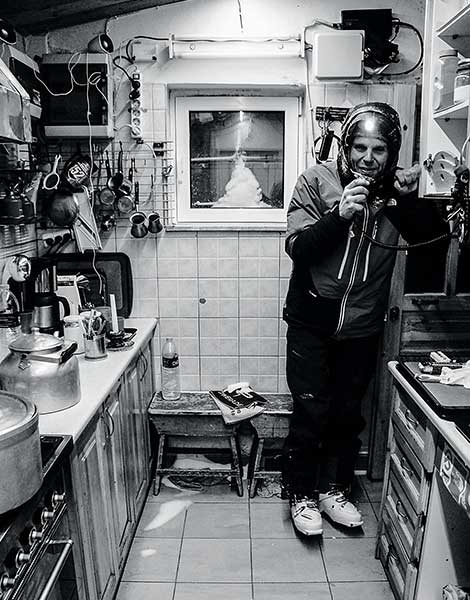
From the snowy kitchen at Kakkalos Refuge, Mike radioes the team at the Petrostrouga Refuge that we’ve finally arrived.
© Anne Viry-Babel
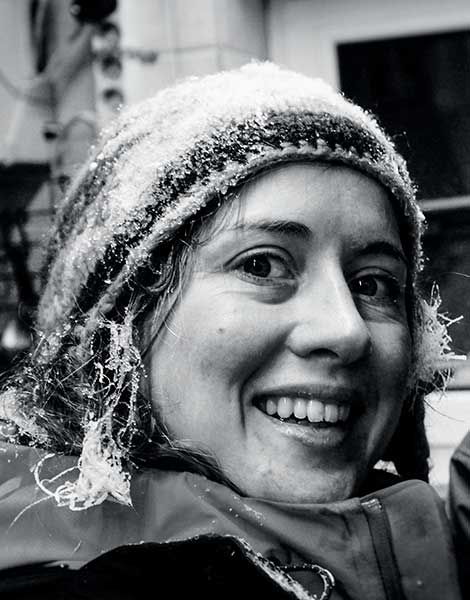
After an exhausting and frightening ascent, I’m delighted to finally reach the refuge, but it will be a few more days before we can heat the place.
© Anne Viry-Babel
Shouldering 40kg backpacks, the group climbed high towards the snow-covered mountain summit. Truth be told, I wasn’t carrying much weight myself. Nonetheless, I can readily admit that I had completely underestimated the difficulty of the terrain and the length of the ascent, and to this we can add the complication of filming our journey.
That first night in the refuge, I doubted the wisdom of pushing to the summit the next day. However, the prize was to be the first crew to film a winter ascent to the summit. I knew the footage from the peak would be spectacular. I could see it from the refuge window.
This climb was the first time I had ever worn crampons. Until then, my mountaineering had consisted of some summer hiking and winter skiing. In comparison to Mt Olympus, the French mountains seemed so organized, with rescue teams, helicopters and ski lifts running up to 3000m summits.
I thought of the high-elevation chalets that dotted the mountains at regular intervals, offering skiers hot drinks and heated toilets. French refuges are regularly supplied by helicopter. On Olympus, it’s man and mule power only.
The next day, after a 10-hour ascent navigating through rock and snow using piolets (small ice axes) while transporting a 14kg camera and a 15kg tripod, we reached the summit just before the sun started to dip under the horizon. Soon after, I found myself hanging from a rope down the Mytikas Couloir, half desperate, trying to find my way down with only a faint headlamp offering me light. I prayed that the battery would hold out long enough for me to make it back alive. Falling would surely mean death: the drop was 2000 meters, and there was nothing to slow or stop me, just frozen air. Framing this scene, I see the shimmering lights of Thessaloniki. So close. I had never felt so far from civilization.
The next morning, the sky shone clear and azure blue. Visibility was perfect all the way down to the sea. Our shoot had been a success. I was alive and I had captured unique footage, to edit upon my return. Olympus had offered absolute, pristine, white beauty. It was no surprise that the ancient Greeks had placed their gods in this awe-inspiring place!
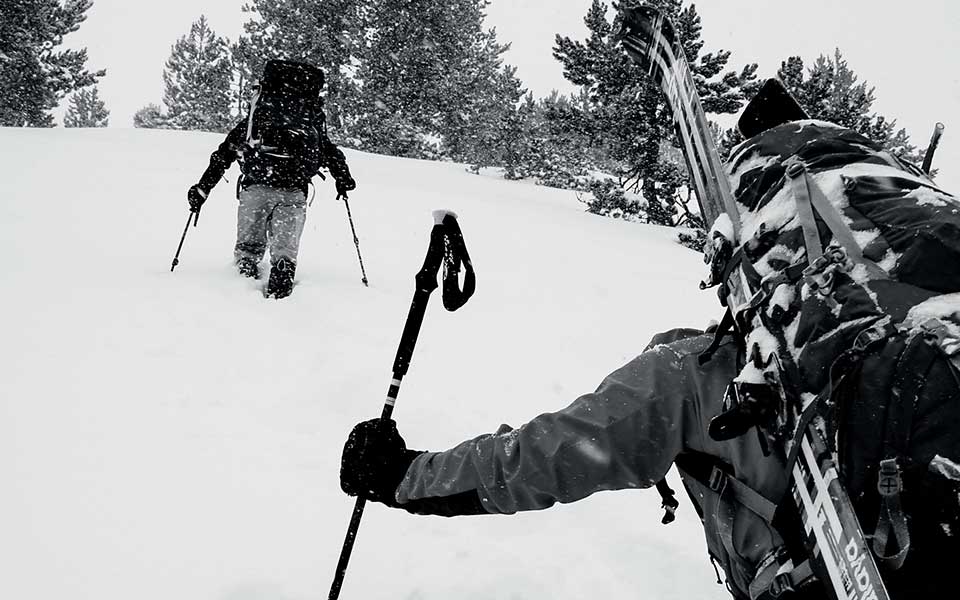
In deep snow, our progress is slow and exhausting. In the end, most of the people expected to spend New Year’s Eve at the refuge turned back because of the weather.
© Anne Viry-Babel
The legend of Mt Olympus lives year-round. It can be found in the dead tree that stands in Petrostrouga, struck by one of Zeus’ thunderbolts. You can feel it when your tent shakes from the reverberating claps of nearby thunder. You can touch it, as you caress the tortured trunks of ancient pine trees.
As the sun sets over Poseidon’s realm, you can witness the mountain’s perfect pyramidal shadow being cast upon the sea. You can see it; as if by magic, Zeus’ face has been carved by nature on the front of the Stefani, a perfect summit in the shape of a throne. You can smell it when spring flowers bloom on the plateau where the muses dance. It can change your destiny.
Somewhere on Laimos, I did fall… in love. Since then, I’ve returned countless times to this special place, seeking to capture its beauty on film. The mountain filters out many things: cars, pollution, humans and their problems.
But the mythical wonder of Olympus is under threat. Mortals are knocking at the door of the divine realm. WiFi has entered the refuges, bringing an addictive connectivity with the world below. In summer, hikers swarm as they attempt to ascend the summit. Accidents are becoming worryingly frequent. The refuges are under such pressure that they’re running out of water. Climate change has started to drain water resources, as rain and snow become increasingly infrequent. Villages and farmland on the slopes are under threat.
As long as winter returns, however, the myth and the magic will endure. Winter on Mt Olympus reminds us of our vulnerability. It brings us back to our fragile condition. One interpretation of “Olympo” defines it as “the everglowing mountain.” In ancient times, during the Late Antique Little Ice Age, Olympus was covered with snow and ice year round, granting it the perfect shield from human interference, and making it the ideal refuge for the gods.
Anne Viry-Babel is a French documentary filmmaker specializing in adventure and nature. She has shot footage in mountains all over the world but always returns to Mt Olympus.
From Crete to Olympus, hike the...
From Santorini sunsets to ancient ruins,...
Discover five mountain destinations where crisp...
City or mountain? Urban strolls or...